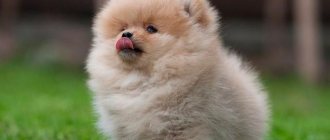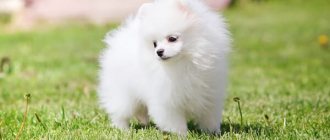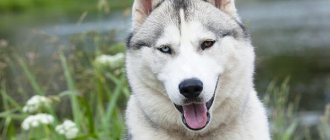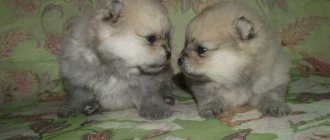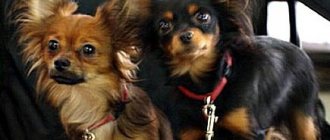Many owners of Pomeranians get them for the purpose of further breeding. To obtain healthy, high-quality offspring, you need to carefully prepare, choose a partner and create comfortable conditions for mating a Pomeranian. If the rules of crossing are followed, the dog becomes pregnant and develops without problems, and childbirth takes place without complications. To achieve a positive result, you need to familiarize yourself with the basic conditions and requirements for mating and further steps for caring for a pregnant bitch.
At what age can you breed Pomeranians?
To avoid mistakes, the time for breeding dogs is selected very carefully. Mating too early is detrimental to the health of the bitch. By the time of mating, both parents must be fully formed physically. At the age of one year, Pomeranian males reach sexual maturity, females have their first heat, but during this period it is unacceptable to breed them. Only at 2 years are the reproductive cells considered sufficiently formed for the reproduction process, therefore it is recommended to breed males no earlier than at the age of 18 months, and to breed females at 20-24 months.
Types of matings for Spitz
After choosing a partner for your Small Pomeranian, you can mate him with one of three types of mating. The choice depends on which one is most comfortable for the animals.
Natural
This type of crossing is characterized by minimal or complete absence of human intervention, which is why mating is called free mating. Since the process is long, the main task of dog owners is to provide comfortable conditions for the animals. The place where it is decided to tie the Spitz should be secluded, hidden from prying eyes. At first, the male takes care of the female, and after some time natural mating occurs.
Control
If the animals are healthy and the mating was carried out during the period of ovulation, then the likelihood that it ends in fertilization and pregnancy is very high. There is no need for control mating. But there are cases when the period of ovulation and the complete maturation of the egg do not coincide in time with the “hunt” in female Pomeranian Spitz. In this case, they resort to repeated control mating. It is carried out a day or two after the first.
Manual
In order to breed oranges by hand, it will take less time than with natural mating. The process is controlled by a maximum of three people - dog owners and a dog trainer. Immediately before mating small German Spitz dogs, the bitch’s loop is lubricated with baby cream or Vaseline. The owner calms her down and holds her by the collar. The owner of the male dog brings him to the female from behind and guides him.
The importance of coat color for a dog
Color is one of the most important parameters for any Spitz. Not only its cost depends on this, but also the possibility of recognition by specific clubs. For example, a black Spitz with beautiful long hair, although it looks very impressive, is valued much less than a blue one. The latter are born much less frequently, so this color is recessive. Based on this, it is not surprising that a marbled Spitz, distinguished by its rarity and visual appeal, can be sold at a higher price than a white or brown Spitz.
If the color of a puppy does not meet the requirements of the club and the Federation to which this club belongs, it may well be rejected as a discreditable standard. If parents give birth to a large number of rejected puppies, then the question of their exclusion from the club may well arise.
To obtain puppies, they strive to use only specially selected dogs that perfectly comply with the rules. This means that everything about them must be perfect - paws, muzzle, type and length of fur and, of course, its color.
On what day of a female dog's heat can she mate?
To understand when to breed a Pomeranian girl, you need to analyze the estrus cycle. On average it lasts 22 days. 5-12 days before the start of the “hunt” the bitch shows interest in male dogs, becomes playful, but does not allow them to approach her. The most difficult thing is to determine ovulation. On the first day of estrus, the level of luteins increases, on the third day the egg begins to mature and after three days it is ready for fertilization. It is better to breed and breed Pomeranians on the fifth day of estrus. It is possible to conceive dogs in the next 3-4 days, since conception is quite possible.
Experienced breeders focus on the average period for mating Spitz dogs - from 10 to 14 days from the start of the “hunt”.
Cream
A cream-colored German Spitz may not immediately acquire its permanent shade.
Sometimes puppies are born completely white and only after the next molt they become creamy. This is why it is difficult to determine what color of fur a dog will have while he is still small. In addition, cream color can also vary from light tones to the darkest.
Similar article: Peculiarities of shedding and caring for Spitz hair
How to properly untie a male Spitz?
The male, who is going to be used as a breeding male, is untied at the age of 10-12 months. For the first mate, an experienced, active and calm female is selected for a young male. She should be in full “hunt”, ready for mating - stand and not turn her tail to the side. The best option is that the dogs are well known.
In order not to reduce the male's interest, he is kept separate from the female before mating. Pomeranians should be mated in a room that is familiar to the male. There should be no bright lighting, bustle or noise.
If a male dog mounts on his own, a hand is placed on his croup and held. He will gradually understand that this action is a mandatory mating ritual and he needs to get used to it.
If attempts to untie a male Pomeranian are unsuccessful, he is taken to an adjacent room for rest, and after some time he is brought back again and given the opportunity to mount him.
Unrecognized colors
Some colors cause serious conflicts between representatives of the American Kennel Federation and the FCI. The first has less stringent requirements, and the following colors are acceptable:
- tricolor;
- blue;
- brindle;
- beaver;
- chocolate sable;
- blue and tan.
However, the World Federation of Canine Breeders firmly stands on its own, believing that all these options are a deviation, and their carriers should be immediately discarded and not allowed to reproduce.
Spitz puppies look like bear cubs
Creating and maintaining color standards is quite complex and painstaking work. And every breeder should know about them in order to be able to choose exactly the option that suits him and does not create unnecessary problems in the future.
Unscheduled mating
Unscheduled mating among Pomeranians is the production of a litter if one of the parents is unknown. They happen extremely rarely, since owner oversight is practically impossible. Few breeders let their dog walk unattended. An unplanned mating can be considered a pregnancy that occurs in a bitch when she has not yet recovered from the previous one. In this case, breeding may be extremely unsuccessful due to low immunity and possible diseases of the puppies.
From the standard: Black, brown, white, orange, wolf, other colors (the concept of “other colors” includes colors such as cream, cream-sable, orange-sable, black and tan and spotted. Spotted must have a white base color, as well as black, brown, gray or orange spots distributed throughout the body).
The main color alleles common in the breed:
aw - is widespread in this breed, causes zonal gray (wolfish), may also be present in some red-colored dogs that are carriers of its alleles.
au - determines the formation of the so-called sable color, is widespread in this breed, and is present in many red dogs. at - causes tan and sable colors. B - determines the synthesis of black eumelanin, present in dogs of all colors, except brown and fawn (cream) with a light nose. b - determines the synthesis of brown eumelanin, present in dogs of brown and fawn (cream) colors with a light nose. C —determines a color of normal intensity*. cch - can cause the development of some weakened colors, including white, as well as tan color with white or grayish tan*. c — determines the development of white color from birth*. D - determines the development of color of normal intensity. d - causes the formation of lightened colors, in particular blue. May also be present in some highly bleached cream (fawn) and white dogs. Em - determines the development of a dark mask; For Pomeranians, the mask is a breeding marriage. E - promotes the spread of eumelanin throughout the dog's body. e - causes one of the types of red colors. K - determines the development of a solid color of the eumelanin group. kbr - determines the development of brindle color. k – allows the development of zonal, sable, black and tan colors. T - causes the development of dark spots on white spots. Appears only against the background of white spotting. It is impossible to talk about the presence or absence of this allele in dogs of solid color. t —no speck. S - causes a solid color. s - causes the presence of white spots. Since many representatives of the breed have white markings of greater or lesser extent, it can be assumed that most of the representatives of the breed are homozygous carriers of these alleles. sw - causes extreme spotting. *Note. The symbols С , с and сch are used according to the old tradition due to the lack of data on the new designation of the genes responsible for this trait.
Basic colors of Pomeranians
Black color Black Spitz have a uniform color. The main color-forming genes for black color are B-C-DEK- . All these genes are completely dominant over the recessive genes of the same loci. In addition, dogs with heavily blackened tan and homozygous carriers of the atatkk . With this color, the dog sometimes has light spots only above the eyebrows, under the tail and at the ends of the paws. In dogs with a good undercoat they can become almost invisible. The normal black color is dominant over all other colors. Thus, black dogs can be carriers of genes that initiate the development of all standard and non-standard colors. Therefore, crossing black dogs with each other, and even more so with colored individuals, constantly leads to the appearance of puppies of a wide variety of colors. Some black Spitz have a lightened undercoat, resulting in a strong lightening of the overall color; The mechanism of inheritance of this trait has not yet been established. Brown Color Like black dogs, brown dogs can have different types of colors - both solid and camouflaged tan. The main color-forming genes for brown color are bb-C-DEK- . Zonar gray (wolf) color The color-forming genes for this color are the awawB-kk . Gray dogs may be lighter or darker in color and may or may not have a mask. The absence of a mask is the norm for small varieties of Spitz. The darkening of the color may depend on the action of specific modifier genes, or polygenes, that initiate a larger or smaller width of dark or light zones of the hair. The shades of this color largely depend on the presence of alleles that lighten the pheomelanin zones of the hair or modify them almost white. Tan color The tan color of Spitz dogs is quite common. The tan has very clear outlines, which are obtained due to the presence of separate eumelanin and pheomelanin zones located in strictly defined places on the dog’s body. This pattern can be formed by a combination of either black and yellow or brown and yellow pigments. Black and tan color is formed in the presence of genes that determine the synthesis of black eumelanin B- , and brown - in the presence of bb . Therefore, the black and tan color is dominant over the brown and tan color. The main color-forming genes for tan color are аtаtkk . Genes at different loci that modify red coloration can contribute to the lightening of tan coloration. Colors of the red range Pomeranian Spitz have different types of red colors - sable (dominant red), caused by the ayayE-kk , as well as a group of colors caused by the action of its recessive alleles. Sable color Dogs of this color are red with dark ends of the hair. The relative length of the dark end of the hair can vary significantly, resulting in a lighter or darker color. This distribution of pigments throughout the hair is determined by the ay , but the effect of this gene can only manifest itself in the presence of a pair of recessive genes kk . Another color-forming gene for the sable color is the dominant E- , which allows eumelanin to spread throughout the dog’s entire body. Sable-colored dogs often have a dark mask of varying length, due to the action of the Em . The tone, intensity of the red color and the relative length of the dark ends may depend on the presence of a variety of factors, both genetic and non-genetic. Bright red Spitz dogs are called orange Spitz dogs. Sable color has pronounced age-related variability. Puppies that retain puppy fluff are gray in color and look like wolf-colored puppies, and their typical color appears only after they change their coat to an adult one. Some sable-colored Spitz dogs with age almost lose the dark coating on their coat and become almost pure red. Pure red color Unlike sable-colored Spitz, puppies of this color are born pure red - without the slightest trace of black shading. Its recessive pair of genes does not allow eumelanin to spread throughout the dog’s entire body, but allows its synthesis in the skin - nose, lips, eyelids. Her genes do not allow many genes that determine the development of a particular color, including dominant ones, to manifest themselves externally. Thus, red dogs of this type can be hidden carriers of genes for any other colors. Because of this, crossing red dogs of the first and second types with each other can lead to the birth of puppies of a wide variety of colors, including black. And since it is not always possible to visually determine what type of red color a red dog has, in some cases the birth of puppies of a different color from two red Spitz dogs may be unexpected for the owners. To accurately identify the genetic essence of the red color, it may be necessary to conduct molecular genetic testing.
Lightened colors Among the red range of Spitz colors, a significant share is made up of lightened colors - cream of various shades. They can be caused by a variety of genetic factors. Thus, when the genes for the brown color bb and ee , a lightened version of the red color is obtained, accompanied by a very lightened nose and lightened eyes. In addition, lightened colors can be caused by the action of genes that reduce the level of synthesis of the yellow pigment pheomelanin, and others that act in a similar way. The combination of the action of these genes can lead to a very strong, even almost white, lightening of the red color. Thus, Spitz dogs with bleached red colors that are identical in appearance can have completely different genotypes. These dogs can be latent carriers of almost all possible color genes. As a result, when crossing lightened dogs of different genotypes with each other, the birth of puppies of any color is possible.
White spotting White spots on the background of the main color are caused by the presence of a pair of recessive genes ss . White spotting can range from isolated white spots on the chest or toes to almost white with small black spots. This extreme degree of spotting is determined by the presence of the sw .
Two-tone color (party color) This group includes dogs of different main colors with white markings of different sizes, caused by recessive alleles of the s . Spitz dogs with spots of varying lengths are often born when colored dogs are crossed with white dogs. This phenomenon indicates the wide distribution of s in the breed group. The standard option for Spitz is only spotted color - dark spots on a white background.
White color Like red, white color can also be of several types. It can be formed in different ways during ontogenesis. In some cases, puppies are born pure white, while in others they are fawn of varying intensity and lighten with age. White color can be caused by various hereditary factors. Some genes can directly influence the synthesis of melanins. Others may prevent pigments from entering the hair. At the same time, different genes influence the cessation of synthesis of eumelanin and pheomelanin in hair. The synthesis of eumelanin is stopped under the influence of a pair of recessive genes. The level of pheomelanin synthesis can be influenced by various factors, most of which have not yet been identified. Until recently, it was believed that in dogs, like other animals, the synthesis of pheomelanin in hair is reduced under the influence of recessive alleles of the locus C , c , cch , etc. However, molecular genetic studies in recent years have shown that this process occurs due to alleles of another, or rather , other incompletely identified genetic loci. is assumed that the lightening of pheomelanin, leading to the appearance of cream and fawn colors, is associated with mutations in the gene, which is currently designated as I. These mutations result in lightening of pheomelanin without affecting eumelanin. In fact, the action of gene I is similar to the action of the “obsolete” ch . Dogs that are pure white from birth are not albino; they have pigmented nose and oral mucosa. They are called leucists. They often have black or gray skin. Previously it was assumed that this color occurs due to the action of the c gene, which completely blocks the synthesis of pheomelanin in the hair. Research by modern authors confirms the presence of a gene with a similar effect, but belonging to some other locus that exists in addition to the genes of locus I. This allele is recessive and epistatic to all other color loci, so a white dog can potentially have any color. However, as a rule, they are all carriers of the ee alleles. White color, due to leucism, is observed in a relatively small number of Pomeranians. White dogs with a black nose, lips, eyelids and dark eyes are carriers of the B - allele. Dogs that are naturally white with a brown nose are bb . In addition to the alleles listed above, the formation of white color can also be influenced by factors that are not directly responsible for color. Such factors may be: the depth of pigments in the hair, the thickness and degree of transparency of the hair cortex, hair structure, etc. Some white Spitz may have extreme spotting, that is, they have the ss , or more precisely, swsw . This is true for most spotted breeds, such as huskies, bull terriers and others. It is quite obvious that many white Spitz dogs are like this, often having small light tan spots that do not create the overall impression of a spotted color. Crossing such individuals with dogs of other colors, including white, leads to the birth of colored puppies with white spots, so the breeding use of such individuals should be treated very carefully.
Crossing Spitz of different colors Crossing of German Spitz is carried out mainly without any regulations on colors. Because of this, the majority of representatives of the breed turn out to be carriers of a wide variety of genes, and from matings of sires of different colors one can expect the birth of puppies of a wide variety of colors. Black Spitz can be carriers of genes that initiate the development of all other colors. Therefore, crossing black dogs with each other, and even more so with colored ones, constantly leads to the appearance of puppies of various colors. Brown dogs can be heterozygous carriers of genes that cause fawn, as well as brown variants of sable and tan colors. They may also be carriers of genes that contribute to a general weakening of color. Thus, crossing two pure brown dogs with each other can lead to the birth of puppies of colors that are undesirable for the breed: brown and tan, as well as weakened brown (Isabella, lilac, lilac, café au lait, etc.). Gray dogs can be heterozygous carriers of genes that cause red and tan colors. When crossing them with each other, the birth of red and tan puppies is possible. Crossing red Spitz with sable can also result in the birth of puppies of various colors. Particularly unpredictable crossbreeding results are obtained when breeding Spitz dogs of light colors. Internally breeding white, red and tan Spitz breeds produces puppies similar to their parents. It is advisable to breed party-colored Spitz dogs only with each other; crossing them with fully colored dogs may result in puppies with undesirable extent of spotting. Crossing white Spitz dogs with colored ones is undesirable, as it can lead to the birth of puppies with an undesirable type of spotting. Approximate genetic formulas for Spitz colors are a?a?BCDEK- - black. a?a?bbC-DEK - - brown (chocolate). аwawВ-С-D-Э-kkS- - zonal gray (wolf). atatB-CDE- kkS- - black and tan. Red aauV-S-D-E-kk - sable. a?a?В-С-D-eeK-(kk) - pure red with a black nose. Bleached red, cream aauV-cchcchD-E-kk - cream with a black nose. ауауbb cchcchD-Е-kk - cream with a brown nose. a?a?B-cchcchD-eeK-(kk) - cream with a black nose. ауауbb С-D-еекк - cream with a brown nose. White a?a?В-cchcchD-eeK-(kk) - white with a black nose. a?a?bbcchcchD-eeK-(kk) - white with a brown nose. a?a?В-C-(cchcch)D-eeK-(kk)swsw - white with a black nose. a?a?bbC-(cchcch)D-eeK-(kk)swsw - white with a brown nose. Party color a?a?B-C-D-E-K-ss - white with black spots. a?a?bbС-D-Э-K-ss - white with brown spots. a?a?B-C-D-ee K-(kk)ss - white with red spots with a black nose. ауауВ-С-DE-kkss - white with sable spots. awawB-С-DE-kkss - white with zonal gray spots.
Non-standard colors of the Pomeranian Spitz According to the regulations of the RKF, the following colors are considered non-standard: tricolor (tricolor), brindle, merle, blue, brown and tan, blue and tan, brown and tan, derivatives of brown: Biewer (cream with a chocolate nose) and chocolate sable , as well as white “knee socks” and a large white “tie” on a solid color.
Author: Maria Sotskaya. Specialist in animal behavior and genetics, zoopsychology, PhD, owner of the White Pack poodle breeding school
Mating Spitz: basic rules
To breed dogs with guaranteed results, you must adhere to a number of rules:
- create comfortable conditions;
- carefully choose a partner for your pet;
- prepare dogs for mating;
- control the process;
- If necessary, contact a professional dog handler.
Conditions for breeding
To obtain healthy offspring, before breeding Pomeranians, a number of conditions must be met:
- Do not knit until weight problems and pathologies have been eliminated.
- Examine dogs at a veterinary clinic.
- Provide all age-appropriate vaccines.
- Get acquainted with documents and pedigree.
How to choose the right pair?
The bride and groom of the Pomeranian Spitz are selected according to their size. If a girl weighs 2.5-3 kg, it is advisable to breed her with a partner of the same or lighter weight. Their color may vary, but it is not recommended to mate white dogs with colored dogs or mating dogs of Paticolor with other colors. For a female with a male pedigree, a Pomeranian is selected at the club. In other cases, it must meet the following criteria:
- to be healthy;
- meet breed requirements;
- have experience;
- be at the peak of physical fitness.
Preparing dogs for breeding
To successfully breed oranges, you need to prepare for it in advance:
- introduce future partners so that they get used to each other;
- take walks together;
- treat for helminths and fleas in a month;
- prepare a room in the dog's territory;
- cover the floors with non-slip material;
- feed the animals no later than 6 hours before mating;
- give a treat afterwards.
Dog mating
If the male is experienced and the bitch likes it, then natural mating is possible. The male will need help when the girl is larger than him. The little Pomeranian Spitz needs help - raised with a special stand. To prevent aggression from the bitch, she is restrained.
Hand mating is carried out on the floor or table, holding the female and guiding the male. If you succeed in tying, gluing continues for about 10 minutes. If there is no “lock”, the male is held on the bitch for at least 5 minutes. After mating, the animals are allowed to rest for 1.5-2 hours, after which they are walked.
Behavior of owners after mating
After mating, a male Pomeranian needs grooming. It is necessary to wash and treat the skin fold on the genitals with an antiseptic. Use cold water to relax.
The bitch is dried and taken to a quiet place where she can rest. It is necessary to make sure that there are no other males nearby.
Disqualifying faults
RKF admitted a number of serious violations that will lead to disqualification from the exhibition event. These include spots on the coat of any color other than white. The presence of white marks on the tips of the legs or chest is not a fundamental reason to disqualify an animal.
An equally serious violation is a black nose in any type of Spitz except chocolate. The brown one may have a nose that matches the color of the fur.
If the exhibition is held in winter, a lighter nose on an orange, beige or cream Spitz is not considered a disqualifying fault. This is due to the fact that in winter their nose always becomes lighter.
Pregnancy and childbirth
After fertilization, pregnancy occurs, which lasts from 58 to 64 days. In the first two weeks, external symptoms are not expressed, although restructuring of the body occurs. It can be identified by symptoms:
- the bitch becomes more irritable and aggressive;
- as a result of hormonal surges, toxicosis occurs.
At 5-6 weeks, the belly becomes rounded, the nipples turn pink, and discharge appears from the loop. The female orange's taste changes - she may refuse her usual food, but at the same time her appetite grows. The dog is offered a different food to choose from, the portion size is maintained, but the frequency of feedings is increased. The diet should be high in calories, rich in vitamins, minerals, and balanced in composition. The menu includes meat, fish, dairy products, eggs, vegetables and fruits.
Immediately before giving birth, the dog begins to fawn, look for a secluded place, and its temperature may fluctuate.
A Pomeranian litter usually contains 1-3 puppies. In most cases, childbirth occurs naturally and no intervention is required from the owner. You need to be nearby and control the process. If contractions last for 2.5 hours and the puppy is not born, you need to consult a veterinarian. After each baby, the placenta comes out. There is no need to worry if your dog eats it, but you should not give it more than two to avoid causing gastrointestinal upset.
Rare colors
The colors listed above are recognized, albeit sometimes with a stretch, by all federations and clubs. However, there are many other options with which everything is not so clear. Less picky federations are willing to accept them, while others prefer to operate exclusively with standard and long-recognized colors.
Rare colors are usually a combination of several standard ones, but still we should talk about them in more detail.
The sable color is very elegant
Vivid examples are the orange-sable and red-sable varieties. Usually puppies are born almost black. Very often, even experienced dog breeders classify them as gray-black with a slight admixture of red. However, with age, the color changes - the gray and black shades recede, but the red color becomes more and more common. As a result, by the age of one and a half to two years, a mature Spitz is simply unrecognizable.
On a note! According to the standard, all Spitz dogs must have black noses. The only exception is the chocolate color - such a Spitz may have a brown nose. In addition, in winter the nose may acquire a lighter color - this is not considered a defect.
A difficult case is the patikolorny (also known as colored) color. The main color of the coat is completely white, without any specks or shades. But spots of different colors may be scattered throughout the body: red, brown and black. Moreover, it is desirable that they are located completely symmetrically. Although this is not a strict condition, at exhibitions judges usually give preference to just such individuals. But the coat color is considered a fault - if the colored zones are almost completely absent, and there are barely pronounced specks on the paws and face.



